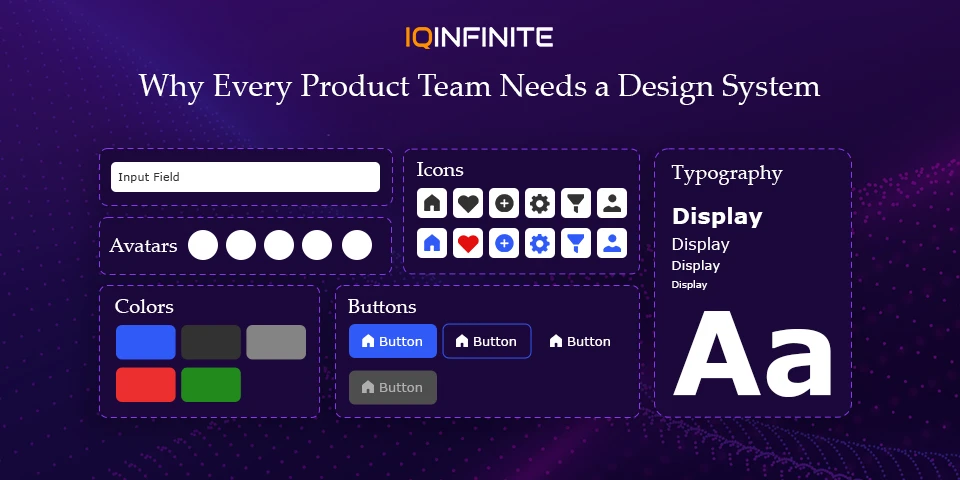Design Systems: Why Every Product Team Needs One

In today’s fast-paced new world of digital innovation, consistency, scalability and collaboration aren’t just nice-to-haves they’re essential ingredients for building exceptional digital products.But as teams expand and product ecosystems grow more complex, maintaining a cohesive design language becomes increasingly difficult.
This is where Design Systems come into play the silent powerhouses that bring structure to creativity, align design and development and enable teams to deliver beautiful, unified experiences at scale.
What Is a Design System?
A Design System is more than just a collection of reusable UI components. It’s a living framework that defines how a product should look, feel and behave. It brings together design principles, patterns, code, documentation and best practices creating a single source of truth for designers and developers.
A typical design system includes:
A typical design system includes:
- UI Components: Buttons, forms, navigation bars, modals, etc.
- Design Tokens: Colours, typography, spacing and icons.
- Guidelines: Usage rules, accessibility standards and tone of voice.
- Documentation: Clear instructions on when and how to use each component.
Famous examples include Google’s Material Design, Apple’s Human Interface Guidelines and Atlassian’s Design System all of which have become industry standards.
Why Every Product Team Needs a Design System
1. Consistency Across Products
A design system ensures that every part of your product from the mobile app to the web dashboard follows the same visual and interaction patterns. No more mismatched buttons or inconsistent colours Users experience a cohesive brand identity, improving trust and usability.
2. Faster Design and Development
Designers and developers don’t have to reinvent the wheel for every new feature. Reusable components speed up workflows and reduce repetitive work. This allows teams to ship faster, focus on solving user problems and spend more time on innovation rather than alignment.
3. Improved Collaboration
A design system acts as a shared language between design, product and engineering teams. Designers focus on experience, developers focus on implementation and both speak the same “system” language. This alignment minimizes handoff issues and design drift, leading to smoother collaboration and cleaner releases.
4. Scalability and Maintenance
As your product grows, maintaining design consistency becomes increasingly difficult. A robust design system makes scaling easy new features automatically align with established patterns and updates can be rolled out across products with minimal effort.
5. Better Accessibility and Quality
Design systems encourage accessibility from the start by including standards for colour contrast, keyboard navigation and ARIA labels. This ensures that your product is inclusive and user-friendly for everyone, regardless of ability.
Building a Design System: Where to Start
Creating a design system isn’t a one-day task it’s a journey toward alignment, efficiency and long-term scalability. Here’s a practical roadmap to set your foundation right:
1. Audit Your Existing Design Ecosystem
Start by taking stock of what you already have. Identify recurring patterns, visual inconsistencies and reusable components across your products. This audit will reveal where fragmentation exists and where harmony can begin.
2. Define Your Core Principles and Design Tokens
Establish the visual and behavioural DNA of your brand. Define your colour palette, typography, spacing, iconography and tone of voice. These tokens act as the building blocks that ensure every experience feels unmistakably you.
3. Build a Centralized Component Library
Create a shared library of reusable components buttons, forms, modals, navigation and more in tools like Figma, Storybook or ZeroHeight. This becomes the single source of truth for designers and developers alike, accelerating collaboration and ensuring consistency.
4. Document Everything Clearly
A great design system is only as strong as its documentation. Provide usage guidelines, do’s and don’ts, accessibility notes and examples. Good documentation empowers teams to make confident design decisions without constant back-and-forth.
5. Adopt, Iterate and Continuously Improve
Think of your design system as a living organism evolving as your product and users grow. Gather feedback, monitor adoption and refine components regularly. The goal isn’t perfection on day one, but continuous improvement over time.
Real-World Example
When Airbnb developed their Design Language System (DLS), they transformed the way their teams collaborated and built products. The DLS significantly reduced design debt, streamlined communication between designers and developers and accelerated overall development.
Designers gained the freedom to experiment and innovate faster, while developers could focus on functionality without worrying about visual inconsistencies.
The outcome? A cohesive, delightful user experience that feels unmistakably Airbnb across every platform and touchpoint.
Designers gained the freedom to experiment and innovate faster, while developers could focus on functionality without worrying about visual inconsistencies.
The outcome? A cohesive, delightful user experience that feels unmistakably Airbnb across every platform and touchpoint.
Conclusion
A Design System isn’t just a tool it’s a strategic investment that empowers teams to build better, faster and more consistently. It bridges the gap between creativity and technology, ensuring that every detail from pixels to interactions reflects your brand’s identity with precision and purpose.
In a time when even industry giants face challenges as seen in the recent Amazon layoffs companies are realizing the importance of efficiency, scalability and unified design operations.
Whether you’re a growing startup or a global enterprise, building a design system today lays the foundation for sustainable growth, efficiency and a unified user experience tomorrow.
In a time when even industry giants face challenges as seen in the recent Amazon layoffs companies are realizing the importance of efficiency, scalability and unified design operations.
Whether you’re a growing startup or a global enterprise, building a design system today lays the foundation for sustainable growth, efficiency and a unified user experience tomorrow.
